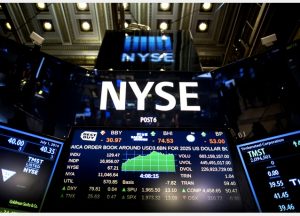 On Friday Dow Jones Industrial Average traded within the range 16,244.65-16,434.76. The benchmark closed at 16,433.09, gaining 0.63% (102.69 points) on a daily basis and extending its advance from Thursday. On September 9th the average went up as high as 16,664.65 to mark its highest level since August 28th, when a daily high of 16,669.97 was recorded. In weekly terms, the US gauge of blue chip companies rose 2.05%, or at the steepest weekly rate since the week ended on March 22nd, when it advanced 2.13%.
On Friday Dow Jones Industrial Average traded within the range 16,244.65-16,434.76. The benchmark closed at 16,433.09, gaining 0.63% (102.69 points) on a daily basis and extending its advance from Thursday. On September 9th the average went up as high as 16,664.65 to mark its highest level since August 28th, when a daily high of 16,669.97 was recorded. In weekly terms, the US gauge of blue chip companies rose 2.05%, or at the steepest weekly rate since the week ended on March 22nd, when it advanced 2.13%.
Among the companies included in the benchmark, 5 posted a daily decline on Friday and 25 posted a daily gain. The most considerable daily drop was observed at Cisco Systems Inc (CSCO), or 0.91%, while, at the same time, the shares of McDonald`s Corporation (MCD) registered the sharpest daily increase within the DJIA, or 2.27%. In weekly terms, 5 blue chip companies posted a decline and 25 were up. The shares of Chevron Corporation (CVX) slumped the most, or 1.15%, which extended the loss, posted during the week ended on September 6th. On the other hand, UnitedHealth Group Incorporated (UNH) demonstrated the largest weekly surge within the DJIA, going up 5.64%, which followed a 4.20% loss in the week ended on September 6th.
Friday macroeconomic reports
The Bureau of Labor Statistics said on Friday US producer prices fell at a lesser annual rate than anticipated in August, 0.8% instead of 0.9%, while the Core Producer Price Index (PPI) rose at an annual pace of 0.9%, outstripping expectations of a 0.7% surge. In monthly terms, producer prices remained flat in August, following a 0.2% increase in July, while core producer prices rose 0.3%, or matching the rate reported in June and July.
Later on Friday it became clear that the gauge of US consumer sentiment, published by Thomson Reuters in cooperation with the University of Michigan, declined more than projected in September. The preliminary estimate of the index was at 85.7 this month, down from a final 91.9 in August and below the median forecast by analysts of 91.2. The preliminary figure has been the lowest since September 2014, when a final value of 84.6 was reported. The gauge of current economic conditions came in at 100.3 in September from a final 105.1 in August, while the index of consumer expectations slipped to 76.4 in September from a final value of 83.4 in August.
According to the report notes by the University of Michigan: ”…consumers grew somewhat more confident that the underlying strength in the domestic economy would insure a continued expansion. The twin strengths of higher employment and lower prices softened the impact from the losses in household wealth. To be sure, consumers still anticipate a weaker domestic economy due to the global slowdown and are less optimistic about future growth in jobs and wages than they were a few months ago.”
Next weeks focus
In the week ahead, global market focus will be on the September 16th-17th policy meeting by the Federal Reserve Bank, at which it is possible that the first rate hike in almost a decade is introduced. It has been a string of 52 consecutive policy meetings, since the target range for the federal funds rate remained steady at 0 to 0.25%.
“Its really Fed watch. Thats what traders are waiting for,” said Tim Ghriskey, the chief investment officer of Solaris Group in Bedford Hills, New York, cited by Reuters. “Theres speculation the Fed might hold off, and if they do, I think well see stocks rally. But to us, its not a question of if the Fed raises rates but when. Its going to happen”, he added.
Correlation with other indices
Taking into consideration the daily closing levels of the major stock indices examined and the period August 1st-August 31st, we come to the following conclusions in regard to the strength of relationship:
DJIA to Nikkei 225 (0.9588, or very strong)
DJIA to S&P/TSX 60 (0.9558, or very strong)
DJIA to FTSE 100 (0.9259, or very strong)
DJIA to Euro Stoxx 50 (0.9256, or very strong)
DJIA to Hang Seng (0.9190, or very strong)
DJIA to CAC 40 (0.9179, or very strong)
DJIA to KOSPI (0.9011, or very strong)
DJIA to DAX (0.8838, or very strong)
DJIA to Bovespa (0.8279, or very strong)
DJIA to RTSI (0.8142, or very strong)
In August, Dow Jones Industrial Average tended to have moved almost equally in one and the same direction with all 10 major indices. The strength of such a relationship was the most pronounced between DJIA and the Japanese Nikkei 225 and the least pronounced between DJIA and the Russian RTSI.
Daily and Weekly Pivot Levels
By employing the Camarilla calculation method, the Monday pivot levels for DJIA are presented as follows:
R1 – 16,450.52
R2 – 16,467.94
R3 (range resistance) – 16,485.37
R4 (range breakout) – 16,537.65
S1 – 16,415.66
S2 – 16,398.24
S3 (range support) – 16,380.81
S4 (range breakout) – 16,328.53
By using the traditional method of calculation, the weekly pivot levels for DJIA are presented as follows:
Central Pivot Point – 16,402.56
R1 – 16,695.18
R2 – 16,957.28
R3 – 17,249.90
S1 – 16,140.46
S2 – 15,847.84
S3 – 15,585.74





